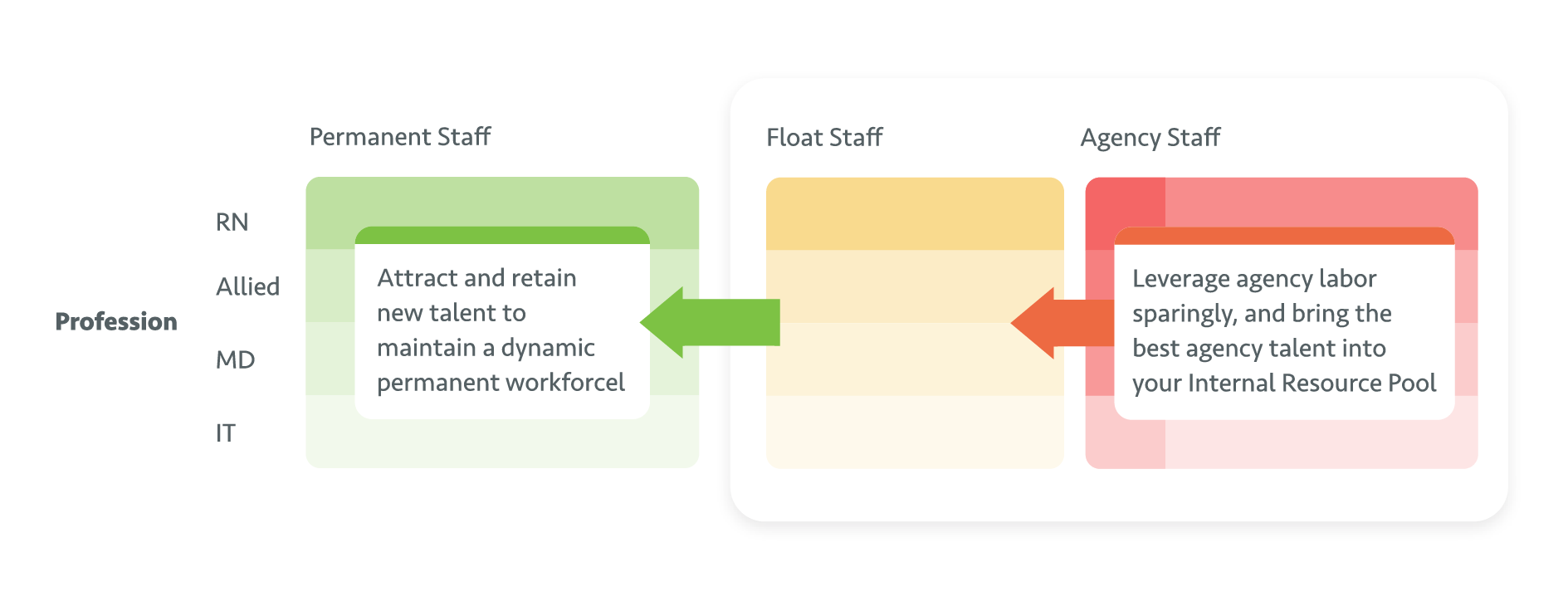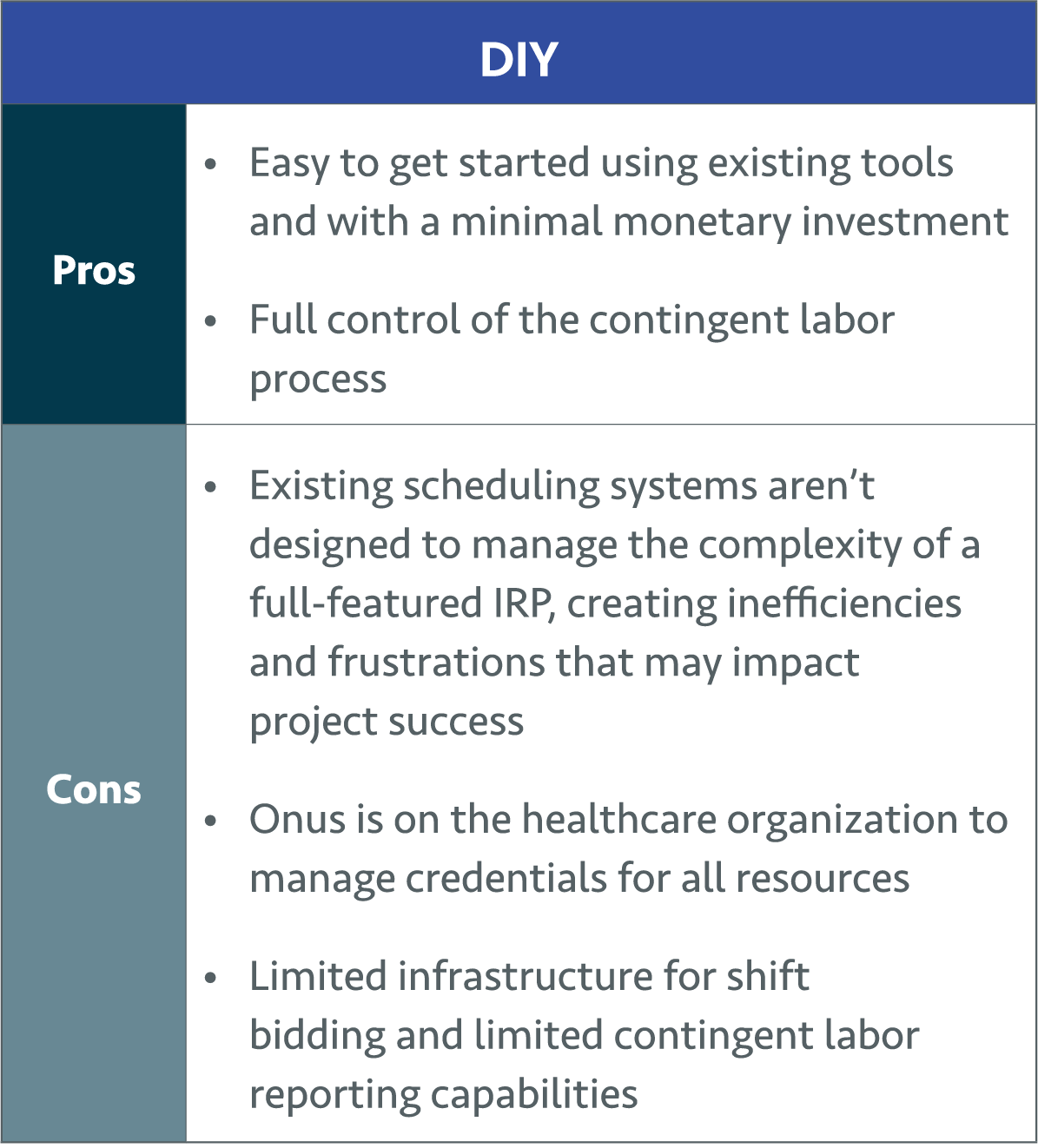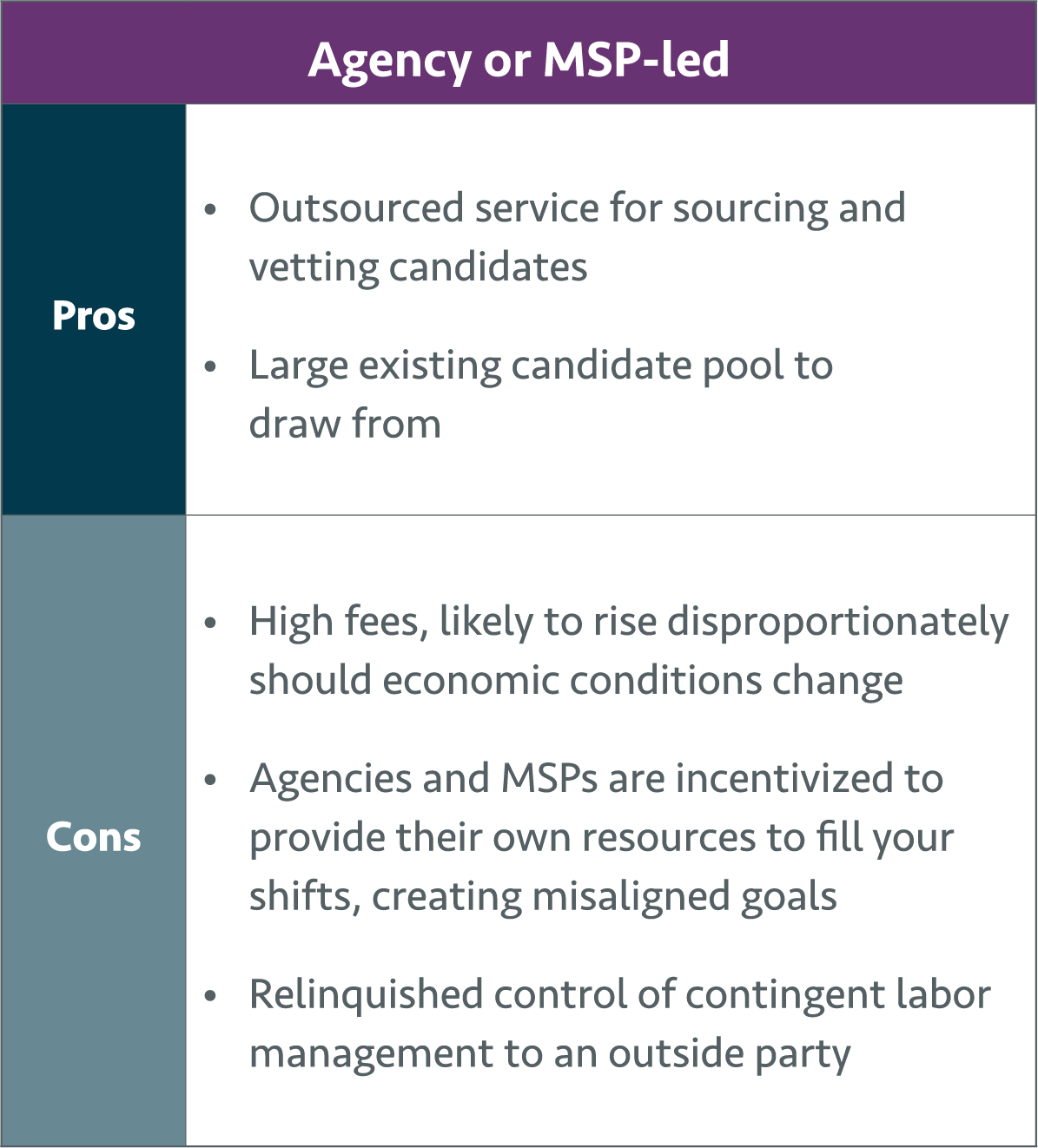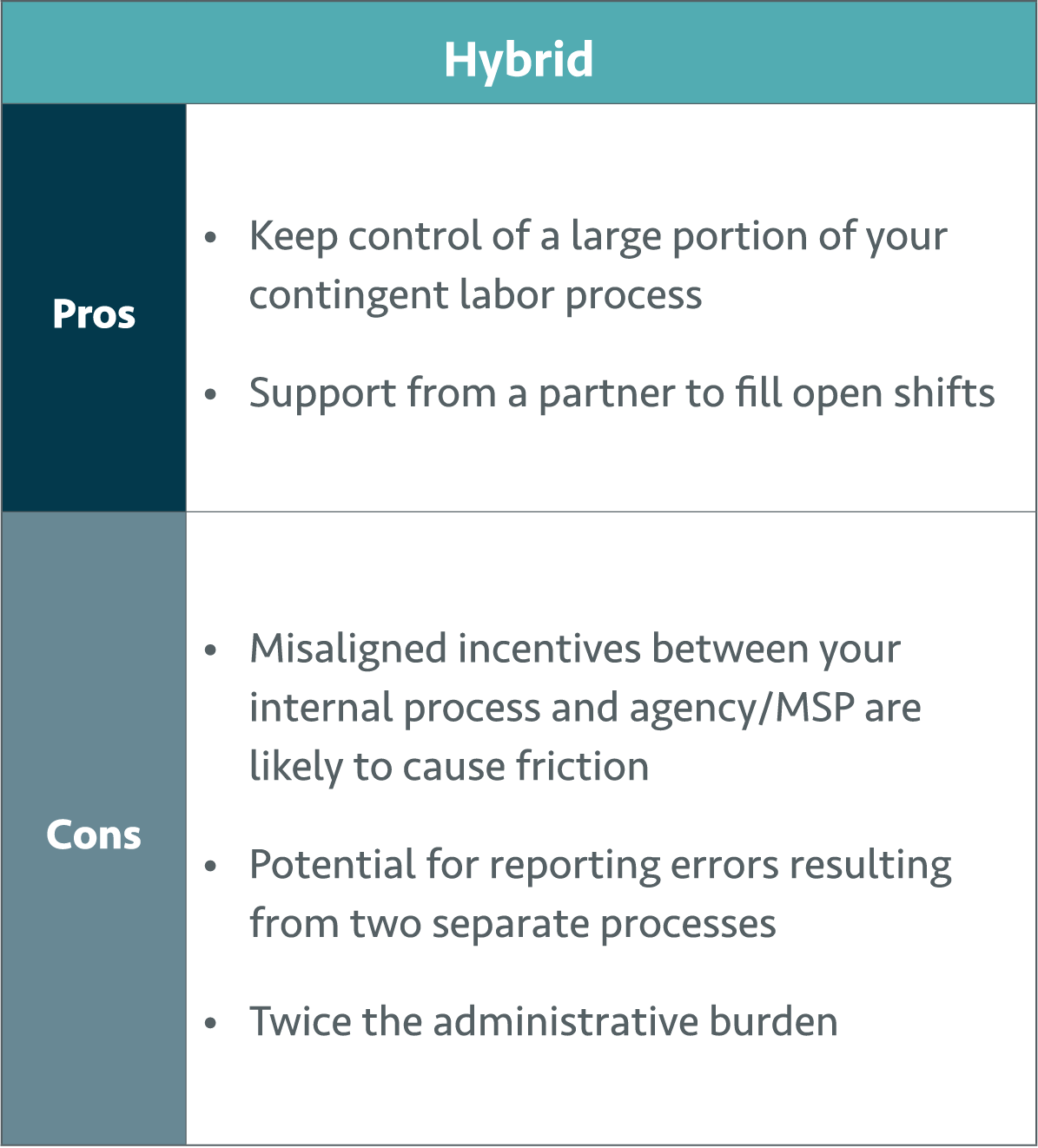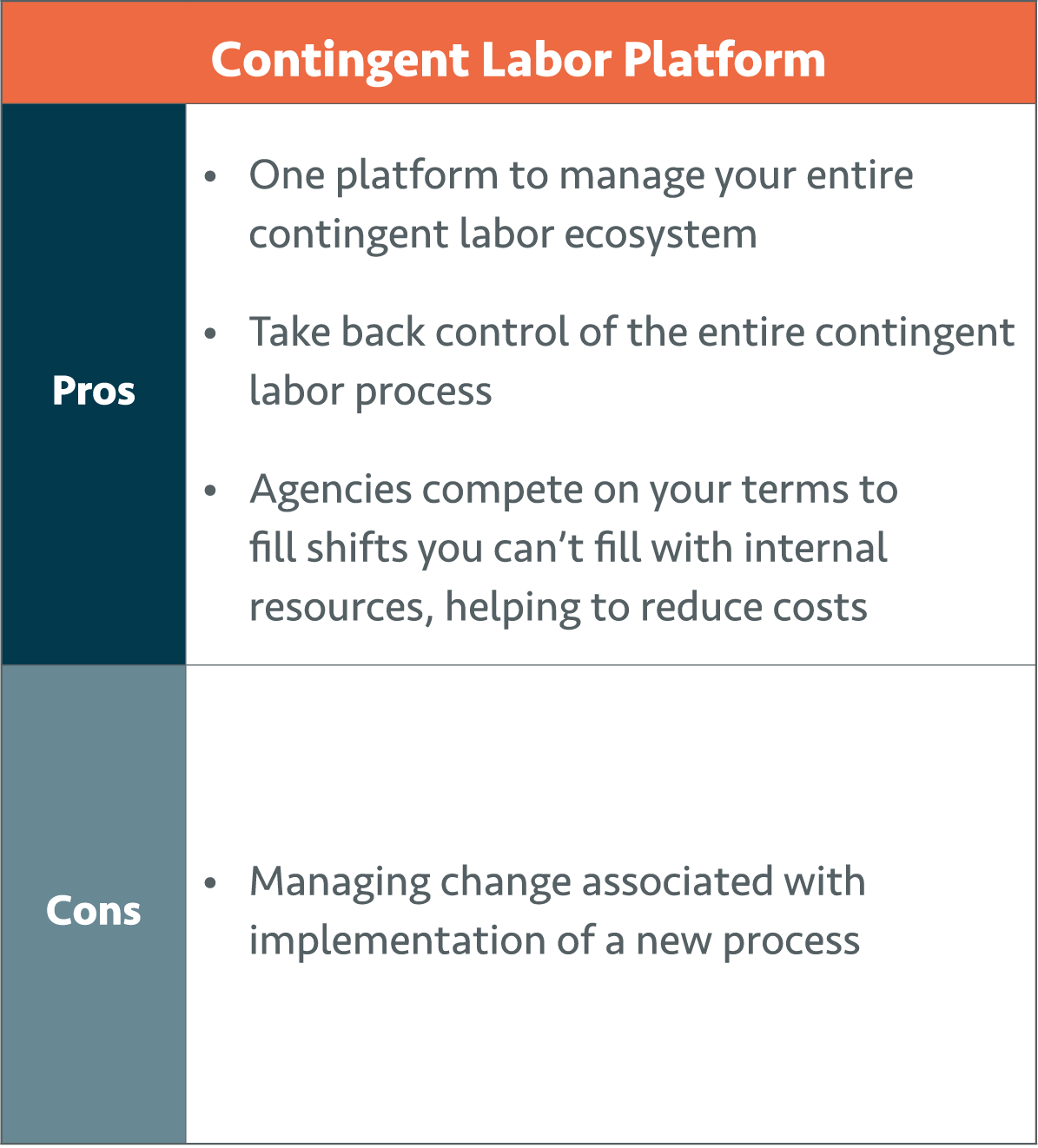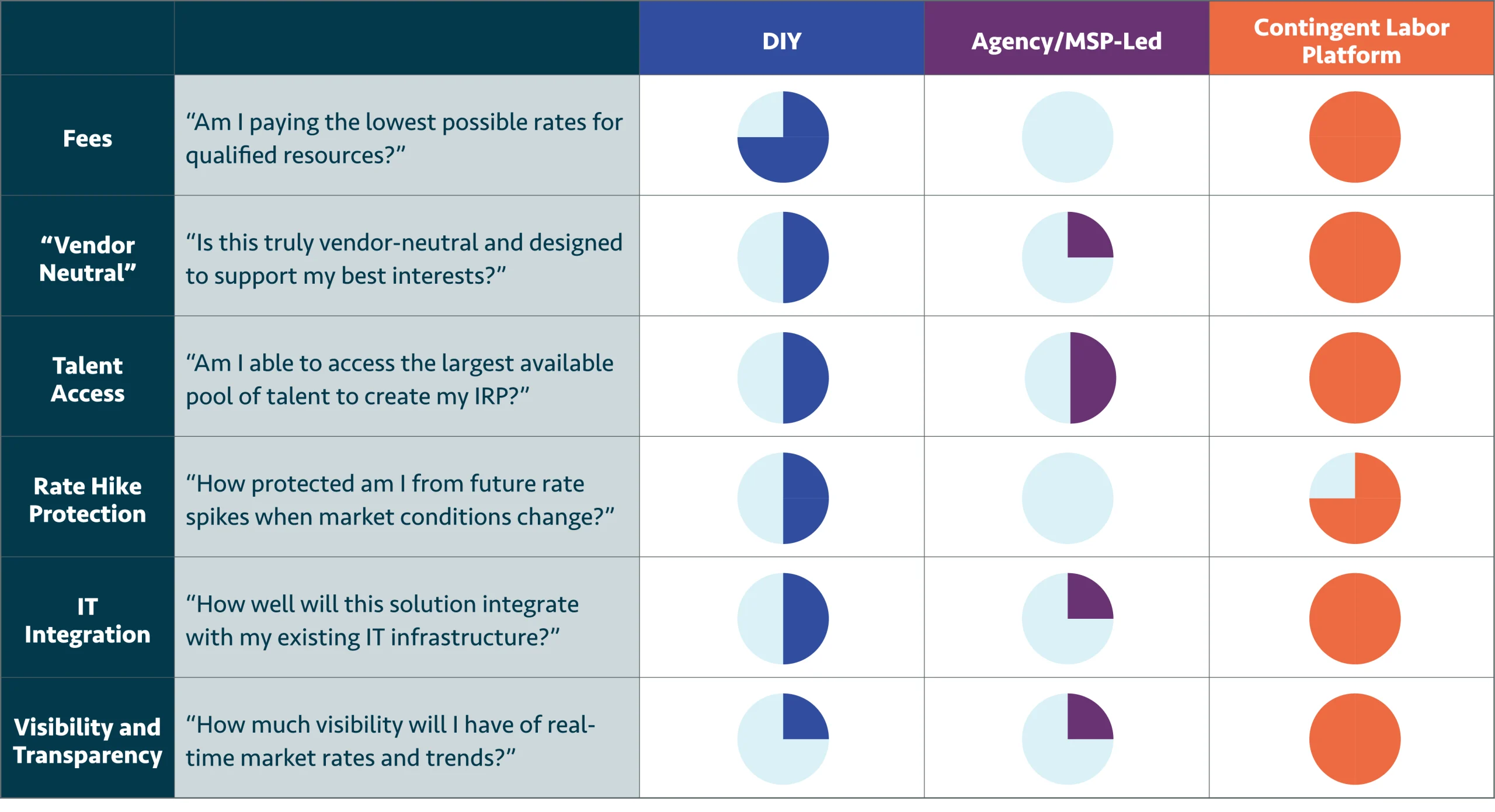A Decision Guide for Healthcare Executives
It’s time to optimize your clinical contingent labor strategy.
Increasingly, healthcare organizations are recognizing clinical contingent labor sourcing as an area ripe for opportunity. Not only can an effective contingent labor strategy generate dramatic cost savings, but it also allows health systems to deliver the best possible patient care while positioning themselves as an employer of choice in their region.
Before committing to a new approach, your organization needs to make an important decision about how to source contingent labor and operationalize the deployment of contingent labor. This guide will equip you with the information you need to ask the right questions and develop the right strategy.

Premium Healthcare Labor Economics 101
The market for premium clinical contingent labor has changed.
On one side of the equation, staffing agencies and managed service providers (MSPs) earned healthy profits during the pandemic era. Now, their focus on financial gain in a turbulent labor market has many health systems questioning if agencies and MSPs’ incentives are misaligned, and whether they can be reliable as long-term partners. Sure, rates have decreased since the pandemic, but how will agency rates change during the next economic swing?
Meanwhile, many nurses and other clinicians are looking for a different way to work. They favor the “gig economy”, value flexibility and balance over traditional working arrangements, and look for well-paid opportunities that best meet their needs. While recruitment and retention are still important, the onus is on the health systems to meet these new expectations and embrace a more modern way of working.
But health systems are caught in the middle, struggling to attract and retain the right talent to deliver quality patient care – all within the constraints of a tight budget. And with slim margins, health systems cannot afford to spend excessively on premium labor.
The Current Cost of Premium Clinical Contingent Labor
The pandemic era staffing crisis may be over, yet the challenge of effectively managing your clinical contingent labor while reducing spend persists, and premium contingent labor rates remain high. For example, the average travel nurse rate is more than 100% that of the permanent labor rate.
On average, hospitals spend $576,0001 in salary for every licensed bed and another $58,0001 per licensed bed on contingent labor, primarily nurses.
* Based on analysis of Hallmark customer results, January 2024
The Ideal Solution: A Robust Internal Resource Pool
What is the optimal solution to alleviate these pressures?
For many health systems, creating an internal resource pool (IRP) has been the answer. While the concept is not new, optimizing the IRP to best meet the staffing needs of your organization becomes the challenge. There are different ways to set one up, however IRPs are most effective with a few core components.

Define your employment models and enroll trusted clinical resources especially new, experienced nurses into a centralized pool of talent
![]()
Provide your clinical resources with access to open shifts via a centralized platform

Allow members of the pool to pick up shifts for set rates
![]()
Ensure the platform is integrated with your existing IT infrastructure –including HRIS and scheduling systems
Inevitably, some shifts won’t get filled by resources from your IRP. For these shifts, the same platform should connect you to a panel of agencies that have been vetted and work from a standard staffing agreement. Then, these agencies can bid on shifts according to the parameters you set to ensure you are getting the right resources at the best possible rate.
When it comes to optimizing clinical contingent labor spend, healthcare organizations need to decrease dependence on external agency staff. The more labor that can be sourced from permanent and float resources, the better. Looking at the figure below, health systems need to shift to the left to gain more control over their clinical contingent labor ecosystem
Choose Your Path: Four Contingent Labor Strategies
Now, it’s time to make an important decision. With a focus on unlocking the value of your existing permanent and float resources, how should you construct your new contingent labor program? There are essentially four paths to choose from:
Do It Yourself (DIY)
Leverage existing systems – such as your current scheduling system – to set up your own IRP and manage the scheduling and deployment of contract resources. Beware of the manual inefficiencies and monitoring/tracking responsibilities that you’ll face with this option.
Agency or MSP-led
Let your agency or MSP partners service your clinical contingent labor needs. In fact, many have introduced technology that they claim is vendor neutral.
Hybrid
You can split the difference: use your existing DIY tools for your IRP and maintain partnerships with agencies and/or an MSP to fill the rest of your shifts. Though, beware of friction and extra administrative burden.
Agency-independent contingent labor platform
Finally, the fourth approach utilizes a platform that serves as an all-in-one solution to help you manage your entire premium labor ecosystem on your terms. The platform offers:
Understanding the Pros and Cons of Each Contingent Labor Strategy
Like any important decision, each clinical contingent labor solution comes with both benefits and drawbacks. Before committing to a strategy, it’s critical to understand how the path you choose will impact your organization.
5 Essential Questions to Ask When Considering a Solution
Before deciding how to take your clinical contingent labor strategy to the next level, it’s important to have clarity around the concepts and components of a holistic contingent labor strategy. Ask the following questions to ensure you have all the information you need.
Is the solution really “vendor neutral”?
This term is often misused in the contingent labor space. Most solutions that claim to be vendor neutral are products of staffing agencies and will either implicitly or explicitly limit you to resources from that agency. A true vendor-neutral solution will not only allow you to create your own IRP independent of agency/MSP influence but will also connect you to a network of agencies that are all working to fill the shifts you specify with qualified candidates at the lowest cost.
How will we ensure staff are credentialed appropriately?
With the creation of an IRP comes the need to ensure that the resources you’re scheduling are credentialed appropriately. And while your organization is doing this already for your permanent staff, the addition of contingent staff increases the volume and complexity of this work – you will not be as closely connected to many of the new resources joining your program. As you anticipate this additional work, know that a true contingent labor platform partner will help you vet and document credentials for your IRP resources as part of their solution implementation.
How will this solution integrate with my health system’s existing IT ecosystem?
To be successful, your solution must integrate seamlessly within your organization’s IT ecosystem including scheduling, time and attendance, and HRIS systems. If not, you may find yourself pulling data “out” and into Excel, burdened with manual reporting, and unable to generate the reporting and analytics you need to make important decisions. Your executive team will expect timely and accurate reporting and your labor resources will expect transparency to maintain their confidence in the program. To avoid these pitfalls, clearly define workflows and reporting expectations early in the process and ensure you have an integration plan to make it happen.
What additional value-added services will I receive?
Working with the right partner to create a winning contingent labor strategy can pay dividends. Ask your partner if they can provide supporting services such as:
- Creation and implementation of standardized staffing agreements to ensure consistency across agency relationships.
- Recurring rate analysis reporting to help ensure you’re optimizing spend, preparing for labor market fluctuations, and aligned with the right agency partners to provide the right support (the right types of resources for the right price).
- Training and implementation support to ensure project success.
What is the best option for my organization long term?
Your overall goals for the program should include straightforward metrics like reducing contingent labor spend and filling shifts quickly with qualified resources. But it should also include more strategic goals including:
- Your health systems’ ability to retain control of staffing during labor market shifts and make decisions that are in your best interest.
- Positioning your organization as an employer of choice in your region to recruit and retain excellent clinical resources.
- Consolidation of the contingent labor staffing function for your entire organization to drive efficiencies and make better strategic decisions.
Your next steps: put this evaluation to work and consider a contingent labor platform
The implementation of a strategic clinical contingent labor program has never been more critical. With clear goals defined and a solid understanding of the available solutions, you can set your organization up for tremendous success. Visit hallmarkhcs.com to schedule your free consultation and learn more about how our contingent labor platform can help you.
About Hallmark
Hallmark offers a fully integrated SaaS platform for healthcare workforce management. The platform streamlines sourcing and deployment of clinical contingent labor and automates the provider lifecycle from contracting to compensation, all with exceptional effectiveness, transparency, and cost savings. Partnered with our advanced strategies and deep expertise, Hallmark’s leading-edge technology solutions empower healthcare organizations to thrive.




